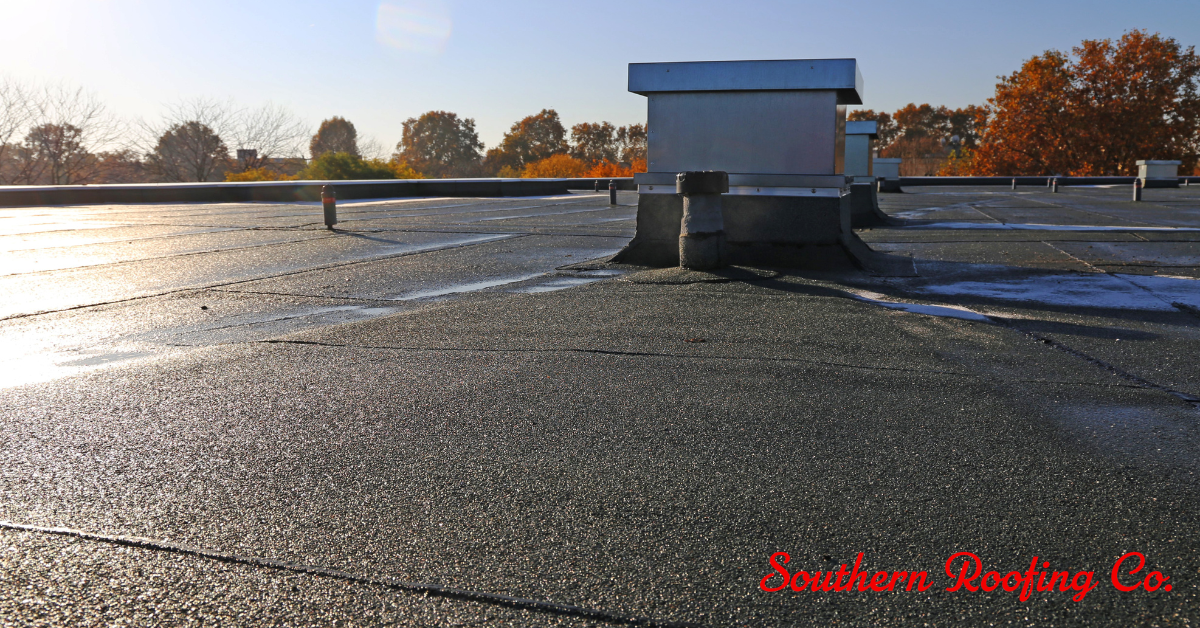
Flat roofs are a common choice for commercial buildings due to their cost-effectiveness and space efficiency. However, their design makes them more susceptible to certain environmental challenges—especially during the hot, humid summers we experience here in Middle Tennessee. Prolonged exposure to high temperatures and moisture can degrade materials, compromise roof integrity, and lead to expensive repairs or premature roof replacement.
In this post, we’ll explore how heat and humidity affect commercial flat roofs, the warning signs of trouble, and how proactive maintenance can protect your investment.
Why Heat and Humidity Pose a Risk to Flat Roofs
Flat Roof Design: Strengths and Vulnerabilities
Unlike pitched residential roofing, flat roofs have minimal slope. This design is ideal for maximizing usable space and is relatively easy to install. However, the flat structure also allows heat and water to sit on the surface longer, increasing the likelihood of damage.
How Heat Affects Commercial Flat Roofs
1. Thermal Expansion and Contraction
What Happens:
Roofing materials—especially those made of rubber or asphalt—expand when heated and contract when cooled. This daily cycle of expansion and contraction, known as "thermal cycling," can cause seams to pull apart, membranes to crack, and fasteners to loosen.
Potential Damage:
- Membrane separation
- Surface cracking
- Warping of insulation materials
- Accelerated material degradation
2. UV Radiation
Flat roofs are constantly exposed to the sun’s harsh UV rays. Over time, UV radiation can dry out and weaken roofing membranes, leading to blistering, brittleness, and discoloration.
Recommended Solution:
A roofing contractor can apply UV-reflective coatings to reduce surface temperatures and slow down the degradation process. Learn more about cool roofing systems from the U.S. Department of Energy.
How Humidity Affects Commercial Flat Roofs
1. Moisture Trapping Beneath the Surface
During humid weather, moisture can become trapped under roofing materials, especially if there is poor ventilation or inadequate drainage. This trapped moisture can rot the decking, create mold, and weaken the insulation.
Signs to Watch For:
- Bubbling or blistering on the roof surface
- Mold or mildew odors inside the building
- Water stains on ceiling tiles
2. Ponding Water
Flat roofs are especially prone to ponding—when water collects and lingers in low spots after a rain. In humid conditions, this water may not evaporate quickly and can slowly degrade the roof membrane.
Long-Term Risks:
- Leaks
- Membrane softening
- Structural damage to the decking or insulation layers
Key Warning Signs of Heat and Humidity Damage
As a commercial property owner or manager, spotting early signs of roof trouble can save you from a costly roof replacement. Here’s what to keep an eye out for:
- Visible cracks or bubbling in the membrane
- Discoloration from sun exposure
- Soft spots that indicate moisture beneath the surface
- Musty odors or indoor water stains
- Loose flashing or separated seams
If you notice any of these, contact a trusted Middle Tennessee roofing company for an inspection.
Best Practices for Flat Roof Care in Hot and Humid Conditions
1. Schedule Regular Roof Inspections
Routine professional inspections are the best way to catch issues early. A qualified roofing contractor will check for seam separation, membrane damage, drainage issues, and signs of moisture intrusion.
2. Install Reflective or Cool Roof Coatings
Reflective coatings can lower roof surface temperatures by up to 50°F, which reduces stress on materials and improves energy efficiency. This can also help reduce cooling costs inside your commercial building.
3. Ensure Proper Drainage
Flat roofs must have a working drainage system to prevent ponding. Regularly clean gutters, scuppers, and internal drains to ensure water flows off the roof.
4. Improve Roof Ventilation
Proper ventilation can reduce interior moisture and temperature, preventing condensation buildup under the roof membrane.
Repair or Replace? Making the Right Call
Sometimes, a roof repair is enough to extend the life of your flat roof. Other times, extensive heat or humidity damage may warrant a roof replacement. Here’s how to decide:
Choose Roof Repair If:
- The membrane damage is localized
- The roof is relatively new (under 10 years)
- There’s no structural damage beneath the surface
Consider Roof Replacement If:
- Widespread blistering or cracking is present
- Moisture has penetrated multiple layers
- Energy costs are rising due to heat-related insulation issues
A professional assessment from a Middle Tennessee roofing company can help you determine the most cost-effective solution.
The Cost of Ignoring Roof Damage
Failing to address heat and humidity damage can lead to:
- Higher energy bills due to poor insulation
- Interior damage from leaks
- Mold remediation costs
- Disruption to business operations
- Liability risks from structural failure
Proactive maintenance and timely repairs can prevent these costly issues and keep your property safe and efficient.
Protect Your Flat Roof Year-Round
Middle Tennessee’s hot, humid summers put commercial flat roofs to the test. Whether you're managing a retail space, office building, or industrial facility, proper care and attention can significantly extend your roof’s lifespan and reduce long-term expenses.
Partnering with a reliable roofing company ensures you have a knowledgeable team ready to handle roof repairs, inspections, and upgrades when you need them most. Request a quote today!

